Yu-Gi-Oh! and Gender: Sexist or Subversive?
The original Yu-Gi-Oh! manga first hit the pages of Shonen Jump magazine in 1996. Kazuki Takahashi’s phenomenal series focuses on a boy named Yugi and the ancient Egyptian pharaoh who possesses his body. Throughout the story, Yugi, the Pharaoh, and their friends defend the world from wrongdoers, not only with supernatural magic, but through playing games, the most notable of which has become a real-life card game.
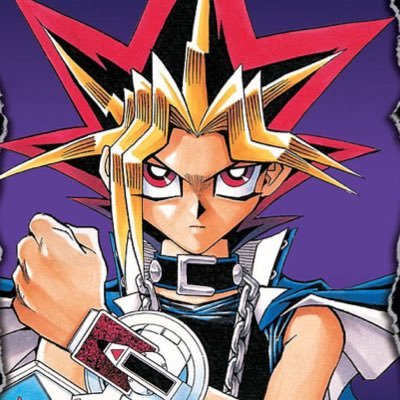
Two years after its debut, Yu-Gi-Oh! received an anime adaptation of the same name by Toei Animation. The franchise was adapted a second time as Yu-Gi-Oh! Duel Monsters in 2000, and it was arguably this series that rocketed Yu-Gi-Oh! to the worldwide popularity it holds today. The two companies that produced Duel Monsters – Nihon Ad Systems and Studio Gallop – went on to create no less than five Yu-Gi-Oh! spin-off series between 2004 and 2019: GX, 5D’s, ZEXAL, Arc-V, and VRAINS. Each sequel series focused on new characters, new settings, new magical powers, and even varied across tone and genre. The franchise went everywhere, from high school coming-of-age stories to tales of cyberpunk dystopias.
Despite the stark differences between each Yu-Gi-Oh! series, many elements from Yu-Gi-Oh! Duel Monsters and the original manga carry over into each spin-off. In every series, the spirits of Duel Monsters trading cards appear as friends and helpers of the main protagonists, for example. The franchise has also reflected similar themes in every series, such as the value of friendship. However, it can also be suggested that some key problems from Yu-Gi-Oh! Duel Monsters have also persisted throughout all six of the anime series. One significant issue plaguing the Yu-Gi-Oh! franchise is its portrayal of female characters.
(After VRAINS, a different production company, Studio Bridge, took over production of the Yu-Gi-Oh! anime, but this article will focus only on the series produced by Nihon Ad Systems and Studio Gallop.)
Representation in the media
While it has always been important, the way the media represents marginalised groups has become a particularly hot button issue in recent years. Academic studies indicate that the media can influence how people can perceive other communities, with “positive” representations sparking inclinations towards respect and acceptance. Similarly, “negative” representations can contribute to feelings of animosity and thus discrimination. The quality of media representation can also impact how members of the depicted community feel about their own identities. Numerous statistics and research studies highlight that, while the media is not the sole creator or destroyer of bigotry, it can play a role in changing how people feel about their fellow humans.
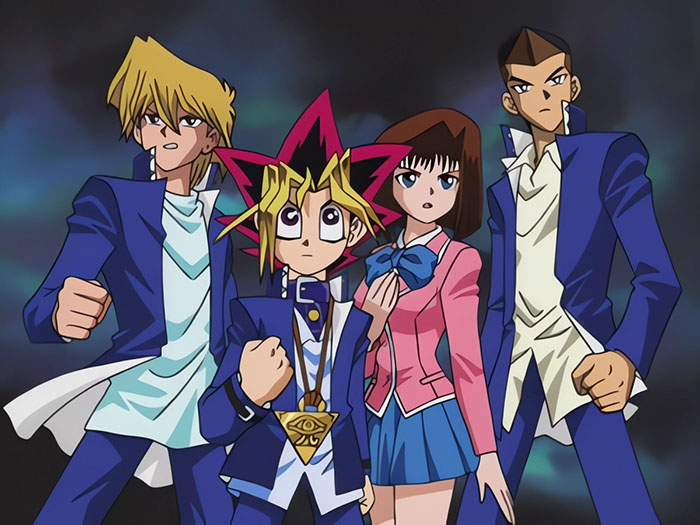
But what is “positive representation”? How can anyone objectively determine if a representation is “good” or “bad”? All humans think and feel differently, even if they belong to the same community, so it is impossible to objectively define a “positive representation” of, for example, a female character. The same female character may cause one female audience member to feel empowered, while another believes the character plays into misogynistic stereotypes, for example. There is no objectively correct answer to the question “what makes a representation good”, and this article will not claim to have the only valid interpretation of Yu-Gi-Oh!’s gender representation. To draw a conclusion on whether Yu-Gi-Oh!’s depictions of gender are sexist or subversive, I will draw on widely accepted ideas and theories about what does and does not support feminism, with the acknowledgement that this topic could also be discussed from other perspectives.
Representations of gender
Discussions of gender representation commonly centre on whether female characters are portrayed as equals to their male counterparts. Whether there are equivalent numbers of female and male characters is often a first port of call to determine if a story is marginalising women and girls. Each Yu-Gi-Oh! series has a predominantly male main cast, so the franchise could be critiqued for its lack of numerical representation.

In addition to representation in numbers, the importance of female characters to the story can be considered. If the actions of female characters advance the plot, it can be suggested that a story has positive representation because it portrays women and girls as taking charge in their own lives. Simply depicting the perspectives of female characters regarding their experiences can also create positive representation, as this presents the thoughts and feelings of girls and women as valid and important. The plot of each Yu-Gi-Oh! anime centres around saving the world, and consequently, characters who are heroes are given the most character agency and narrative emphasis. This article will analyse the ways female heroes are depicted in comparison to their male peers to discuss whether Yu-Gi-Oh! has a positive representation of female characters.
The representation of female characters is also often discussed in relation to several tropes that have been accused of marginalising girls and women. Everyone is likely familiar with the “damsel in distress”, a character – usually female – who is captured and needs to be saved by a hero, who is commonly male. The damsel in distress is problematic in many of its incarnations, as she is often depicted as an entirely passive character who does not even try to exhibit agency or heroism by attempting to save herself. Another harmful trope is “women in refrigerators”. Women and girls who are “fridged” face a significant hardship, often losing their life or otherwise greatly suffering, but the narrative does not emphasis the female character’s experience with her own anguish. Instead, her hardship is treated as “shock value” and/or serves to motivate a male character who demonstrates agency in dealing with what has happened. These two tropes will be discussed in relation to Yu-Gi-Oh! because they are debatably enforced and subverted by the narrative.
Yu-Gi-Oh! Duel Monsters
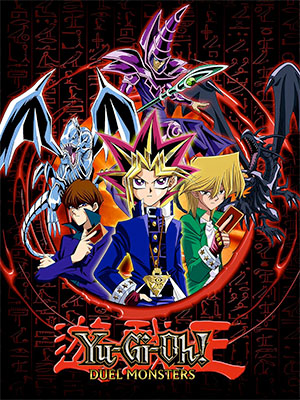
As described earlier, the original Yu-Gi-Oh! story is about a boy named Yugi Muto and the spirit of an ancient Egyptian pharaoh. In the first series of the anime, Maximillian Pegasus, the villainous in-universe creator of Duel Monsters, captures Yugi’s grandfather Solomon, and the two protagonists enter a competition to rescue him. Yugi and the Pharaoh compete in another tournament, run by their rival Seto Kaiba, in the show’s second and third seasons, while trying to defeat Marik Ishtar, an antagonist with knowledge of the Pharaoh’s mysterious past. The show contains some “filler arcs” (storylines not present in the original manga) that delve into Kaiba’s childhood and his rivalry with the villainous Ziegfried von Schroeder, as well as a season-long plot in which the Pharaoh, Kaiba, and Yugi’s best friend Joey Wheeler have to defeat an ancient villain named Dartz. The series’ final season takes the characters back to the Pharaoh’s past in ancient Egypt, where they are finally able to defeat the anime’s main antagonist Yami Bakura.
Those familiar with Yu-Gi-Oh! will be aware that every character mentioned in this plot synopsis is male. The Duel Monsters cast does include some female characters, but they are frequently denied the plot relevancy of their male counterparts.
Female characters in Yu-Gi-Oh! Duel Monsters
Téa Gardner
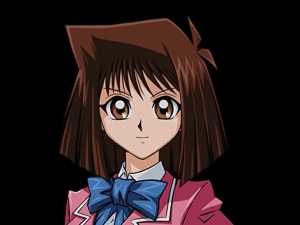
The principal female character in Yu-Gi-Oh! Duel Monsters is Téa, a friend of Yugi’s. She appears in a majority of the anime’s episodes and is an important person in Yugi’s life, but Téa problematically does not play a very significant role in the plot.
In each Yu-Gi-Oh! anime, meaningful contribution to the storyline is usually defined by how many Duels a character participates in and wins. The game of Duel Monsters, in Yu-Gi-Oh!, is not merely a card game, but has supernatural qualities and is a way for characters to advance their goals and to form connections with others. Winning a Duel can stop a villain from causing harm, and even victory in a lower-stakes Duels can be used to signify that a character is skilful or has grown as a person.
Interpreting the Yu-Gi-Oh! Duel Monsters anime through this framework, Téa does not make many contributions to the plot. Despite the Duel Monsters anime having over two hundred episodes, she only Duels twice on-screen. Although she wins both Duels, Téa is never given additional opportunities to Duel and, and thus, to progress the narrative. This is most salient in a multi-episode season two storyline, in which Téa and Joey are brainwashed by Marik. Both characters are mind-controlled, and thus, play a passive role in the plotline, but Joey is given the most narrative importance, as he Duels against Yugi and the Pharaoh, while Téa inactively remains on the sidelines.
Mai Valentine
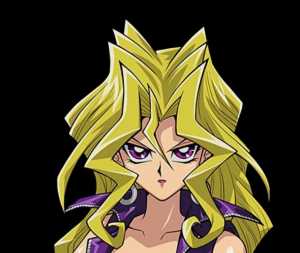
The closest Duel Monsters comes to a female hero is Mai Valentine, an opponent Joey Duels and befriends in the show’s first season. Mai also competes in Kaiba’s tournament in seasons two and three. Throughout these seasons, the audience is told that Mai is a skilled Duelist, but this statement is challenged by her frequent on-screen losses against Joey, Yugi and the Pharaoh, and Yami Marik, respectively. She also surrenders a Duel to Téa. Mai does achieve one on-screen win in these seasons, but it is against a character-of-the-day with significantly less narrative importance than the characters she loses to.
More positively, Mai does receive agency in her character arc. Initially, Mai is self-centred, but she becomes a true friend to Yugi and Joey, which is visibly demonstrated when she helps the two to avoid disqualification in Pegasus’ tournament. Through this arc, Mai is positively given the agency to grow as a person.
In season four’s “filler arc”, Mai’s narrative focus finally matches the agency she exhibits in her character arc, but it comes only when she joins Dartz’s villainous group. Her turn to villainy is actually motivated by an in-universe perception amongst the Dueling community that Mai is not as capable a Duelist as characters like Yugi, Joey, and Kaiba. Mai joins Dartz and is able to achieve an on-screen win against Joey, as well as an off-screen victory against Pegasus. Season four grants Mai more narrative agency than the past three seasons, but it still does not provide the show with a capable female hero, as Mai is an antagonist in this season. She leaves Dartz’s group by the end of the arc, but disappears from the anime after this season, so she does not return to her past heroic role.
Ishizu Ishtar
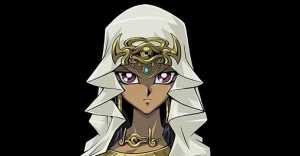
In seasons two and three, Marik’s sister Ishizu aids the heroes in their defeat of the villain. Ishizu competes in Kaiba’s tournament, but loses to him in her only on-screen Duel. She otherwise contributes to the story by giving important information to the Pharaoh and Kaiba. Ishizu’s information does advance the storyline, but the focus is still on what the male characters do with this exposition, as it is Yugi and the Pharaoh who ultimately stop Marik. More positively, Ishizu does exhibit agency by convincing Kaiba to hold the tournament, and a flashback reveals that she actively prevented Marik from obtaining one of the magical Duel Monsters cards he needed for his plan.
Uniquely, Ishizu’s storyline is also one of the few in Yu-Gi-Oh! to directly comment on gender inequality. The Ishtar family are part of a clan dedicated to protecting the Pharaoh’s tomb, with the most central role being passed from father to son throughout the generations. Ishizu’s father selects his biological son Marik to fulfil the role, marginalising his daughter Ishizu and adopted son Odion. Ishizu never directly expresses her feelings on this misogyny, but her father’s discrimination is portrayed as something wrong by the narrative, as passing over Odion and Ishizu indirectly results in Marik becoming a villain and leads to Yami Marik enacting retribution on his father.
Yu-Gi-Oh! GX
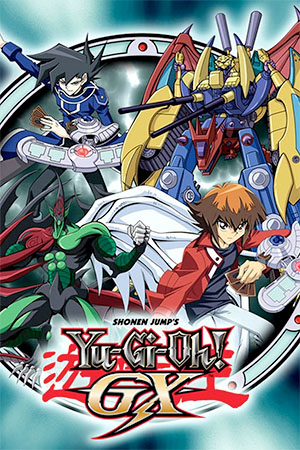
Years after Duel Monsters, Kaiba runs an academy for aspiring Duelists to develop their skills in the game. GX begins with protagonist Jaden Yuki starting at Duel Academy, and early episodes surround his antics at the school, as well as his rivalry with villainous teacher Vellian Crowler. Later in the first season, an evil group called the Shadow Riders – including another teacher named Amnael – attacks the academy. In season two, Jaden deals with a rival Duelist named Aster Phoenix, while the school is infiltrated by a new villainous group, lead by a psychic named Sartorius. The show’s third season introduces Jesse Anderson, an international student who Jaden forms an extremely close bond with. The season’s villain Yubel is in love with Jaden, and when Jesse sacrifices himself to stop Yubel, Jaden himself temporarily becomes a villain. In GX’s fourth and final season, Jaden struggles with depression and must stop the villains Nightshroud and Yusuke Fujiwara from destroying the world.
Like in Duel Monsters, the plots of GX revolve primarily around male characters. The one notable exception to this is Yubel, who will be discussed later in this article. In contrast to Yubel and the male characters, the girls of Yu-Gi-Oh! GX have the limited narrative agency of their predecessors.
Female characters in Yu-Gi-Oh! GX
Alexis Rhodes
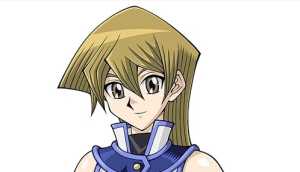
Alexis is the main female character in GX, but she has more in common with Mai than with Téa. Jaden’s fellow student at Duel Academy, Alexis has a passion for Dueling and participates in several Duels over the course of the show.
A recurring plotline in GX is the disappearance of students from the school a year before Jaden starts at Duel Academy. This storyline is introduced into the show by Alexis, as her brother Atticus was one of the students to go missing. However, despite Alexis’ direct connection to the storyline, Jaden is the character who resolves most of the mystery. He Duels and defeats Titan, a Shadow Rider involved in the disappearances, and he is the one to free Atticus from Nightshroud’s possession and his forced membership to the Shadow Riders. Alexis also wins a Duel against Titan, but only after he has already been defeated by Jaden. One could argue that only Jaden could advance the storyline because he is the main character, but this is challenged by the way GX sets up the fight against the Shadow Riders. When the threat of the Shadow Riders arises, a group of seven – that both Jaden and Alexis are a part of – is given the task of protecting Duel Academy, thus providing no reason for Alexis’ narrative sidelining during this plotline.
More positively, Alexis does receive some progressive storylines in season two. The musically inclined Atticus tries to force Alexis to become a pop idol with him, but Alexis refuses and defeats him in a Duel. In another episode, Alexis wins a Duel against and turns down a disrespectful boy with a crush on her. These two standalone episodes positively allow Alexis to exhibit her Dueling skills and to assert independence.
Unfortunately, Alexis’ season two agency does not extend into the main story arcs. Alongside male characters, Alexis is brainwashed into joining Sartorius’ group, and she does not Duel at all in season three. In season four, Nightshroud returns as an antagonist, but Alexis has next to no involvement in the main plotline.
Tania
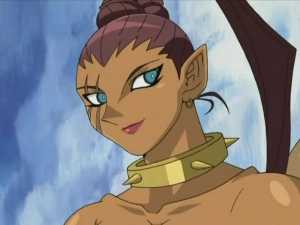
Most Yu-Gi-Oh! antagonists are male, but two of the seven Shadow Riders are female: Camula and Tania. Each Shadow Rider only appears in a few episodes, but in her short amount of screen time, Tania’s character arguably falls into some problematic tropes.
Tania Duels Bastian Misawa, one of Jaden’s classmates. Her motive for the Duel is not only to advance the Shadow Riders’ evil ambitions, but to force Bastian to marry her. This storyline is problematic because Tania’s harmful behaviour is not given the same weight by the narrative as similar actions taken by a male character. In a later episode, Jaden’s classmate Chazz Princeton Duels Alexis to try to make her go on a date with him. GX paints Chazz in the wrong for doing this, and Alexis rejects Chazz after winning their Duel. Conversely, Bastian actually expresses interest in having a relationship with Tania. The show creates a problematic double standard, as Chazz’s wrongdoing receives greater condemnation than Tania’s, seemingly because he is a boy and she is a girl.
Yubel
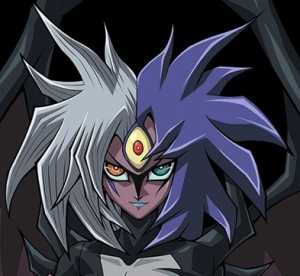
While Yu-Gi-Oh! GX rarely placesits female characters into the spotlight, the anime does include one non-male character who plays a significant role in the narrative. Yubel’s gender is never explicitly stated by the narrative, but in the original Japanese version of the anime, it is made clear that the character’s identity is outside of the gender binary.
Serving as the main antagonist of season three, Yubel not only has narrative agency, but drives the plot, from brainwashing other characters to transporting Duel Academy to another dimension. They are also a skilled Duelist and defeat several opponents, including Jesse, Zane Truesdale, and Adrian Gecko, with Dueling aptitude so high that even Jaden is unable to beat Yubel in a one-on-one Duel. In season four, Yubel joins Jaden’s fight against Nightshroud as a hero and continues to help Jaden in the film Yu-Gi-Oh! Bonds Beyond Time.
Every other “final boss” or “main” villain of the season is male, not only in Yu-Gi-Oh! GX, but in every other Yu-Gi-Oh! anime, so Yubel’s character provides some diversity to the franchise. However, it could also be argued that Yubel falls into some problematic tropes, as an LGBTQ+ villain.
Yu-Gi-Oh! 5D’s
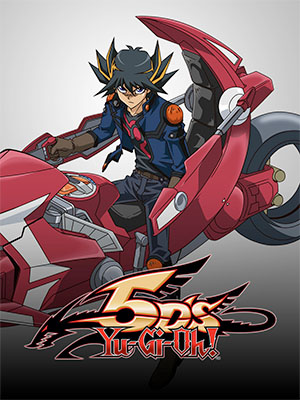
The third Yu-Gi-Oh! series is set years after GX, and focuses on a boy named Yusei Fudo. When 5D’s begins, Yusei lives in Satellite, a poor district oppressed by the rich New Domino City. In the first season, Yusei travels to New Domino City and competes in a Duel Monsters tournament to get back the card his former friend Jack Atlas stole from him before the beginning of the show. During this arc, Yusei discovers that he is a Signer, a “chosen one” with supernatural powers. The other Signers are Jack, a psychic named Akiza Izinski, and a girl who can see Duel Monster spirits called Luna, and the group is later joined by Yusei’s childhood friend Crow Hogan and Luna’s brother Leo. In season two, Yusei and the Signers battle against an evil group called the Dark Signers, led by Yusei’s former ally Rex Goodwin. In the third and fourth seasons of the show, Yusei, Jack, and Crow enter a tag-team Duel Monsters tournament, while New Domino City is threatened by Iliaster, a group of time travellers. The Signers first battle members of Iliaster called the Three Pure Nobles, and in the final season, take on the group’s founders, including their leader Z-one.
Positively, 5D’s focus on the Signers as a group grants more screen time to its female characters than both Duel Monsters and GX. Despite this progressive premise, however, it can be suggested that 5D’s falls into its predecessors’ pattern of spotlighting male characters at the expense of their female counterparts.
Female characters in Yu-Gi-Oh! 5D’s
Akiza Izinski

Akiza is a Signer and is the most prominent female Duelist in Yu-Gi-Oh! 5D’s. Initially, she is an antagonistic character who uses her psychic powers to hurt others, but she undergoes a redemption arc and becomes a hero. Across the first two season of 5D’s, Akiza can be regarded as a positive representation of a female character because she is granted significant narrative agency in her character arc. While Akiza receives help from Yusei, she is able to realise her wrongdoings on her own and independently takes steps to become a better person. As a villain, Akiza wins two Duels in the tournament, and she cements her status as a hero by Dueling and defeating Misty Tredwell, a Dark Signer, in season two.
Unfortunately, Akiza’s narrative agency decreases in the second half of the show. Although she became a hero in season two, Akiza is not given an opportunity to demonstrate further heroism in seasons three or four because she does not Duel against any of the villains. Season three additionally included many “character of the day” episodes in which protagonists Duel one-off opponents, but Akiza is never the focus of these episodes; only Yusei, Jack, Crow, and on one occasion Leo are given these opportunities to Duel.
More progressively, Akiza does receive a second character arc in the latter half of the show. 5D’s introduces a new style of Duel Monsters, known as “Turbo Duels”, which incorporates a motorcycle race into the game (this makes sense in context). In season three, Akiza meets a female Turbo Duelist named Sherry LeBlanc and is inspired to learn how to ride a motorcycle herself, specifically because she becomes aware that girls can be Turbo Duelists. Although Yusei, Jack, and Crow are the official team competing in the Duel Monsters tournament, when Crow is injured, Akiza is able to use her Turbo Dueling skills to fill in for him in one of the team’s matches. The culmination of Akiza’s arc is unfortunately undercut, however, by the outcome of the Duel. Both Akiza and Jack only playing supporting roles in the team’s success, and Yusei is given the most narrative focus because he defeats all three members of the opposing team on his own.
In 5D’s’ final season, every Signer (apart from main character Yusei) wins in a tag-team Duel against one of Z-one’s followers. By Dueling against an antagonist, Akiza arguably does receive more narrative agency than the female characters in Duel Monsters and GX were granted, which suggests that 5D’s improved on its predecessors’ portrayals of female characters. However, Akiza’s Duel against the villainous Sherry comes after two seasons in which she received significantly less involvement in the story than male characters like Jack and Crow. Consequently, it can be suggested that while the writing of Akiza’s character improved on some aspects of Yu-Gi-Oh!’s marginalisation of female characters, there were elements of her character that could have been more progressively handled.
Luna
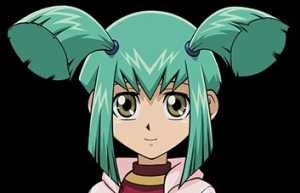
Luna is one of the Signers, which makes her a prominent character in 5D’s. Luna’s twin brother Leo is also an important character, and the storylines of the two are often closely interconnected. Initially, Luna and Leo’s shared plotlines are presented in an equal manner, but like Akiza, it can be suggested that Luna receives less narrative agency in the second half of the show.
In 5D’s’ first season, of the twins, Leo takes the lead in Dueling, but Luna is still given an opportunity to show character agency. When Luna does Duel in the tournament, she is put under a trance, but the show progressively does not reduce her to a damsel in distress. Luna exhibits agency by fighting back against the trance and is able to achieve a draw in the Duel. In the second season, Luna is forcibly sent to the Duel Monsters Spirit World, but she similarly takes an active role in escaping and in resolving the problems plaguing the Duel Monsters.
By the end of the second season, Luna has completed her character arc by developing her Spirit World powers. Unfortunately, her supernatural abilities play a very limited role in the show’s remaining three seasons, and unlike Akiza, Luna is not given a second character arc. She and Leo lose a Duel against Lester, one of the Three Pure Nobles, in season three, and Luna does not Duel at all in season four. As a character, Luna is marginalised because she is not involved in the story’s main plotline, nor does she receive focus as an individual outside of the main plot.
Leo likewise makes few contributions to the central storyline in seasons three and four, but in the show’s final season, he receives a larger role. Luna, Leo, and Jack Duel against Aporia, an important antagonist, but the Duel ultimately grants Leo the most focus, as it is during this storyline that he is finally able to become a Signer. Ultimately, in the twins’ final Duel, Leo completes his series-long arc, while Luna’s narrative sidelining continues. Like Akiza, it can be suggested that Luna’s character began as a positive representation, but that this was not sustained throughout the show because her narrative agency waned throughout the story.
Carly Carmine
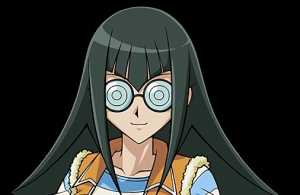
5D’s’ second season introduces Carly as a supporting character. She isn’t much of a Duelist, but is given narrative agency because the show nonetheless presents storylines from her perspective. The audience follows Carly as she takes active steps in her work as a journalist, such as tracking down Jack for an interview. Carly loses a Duel and then her life to the villainous Sayer, but is reborn as a Dark Signer and demonstrates her status as a serious antagonist by defeating him in a rematch. Jack Duels Carly to stop her villainy, but it is Carly herself who purposely loses the Duel once she realises that she is doing the wrong thing. Across the season, Carly is able to make several active decisions despite her underdog status and is resultantly a positive representation of a female character.
Like Akiza and Luna, however, Carly’s character is weakened by the latter half of the show. She does not remember her time as a Dark Signer, which prevents Carly from having any character development from or agency in addressing her villainous actions. This serves as a sharp contrast to one of the male Dark Signers, Kalin Kessler, who retains his memories and receives a seven-episode redemption arc. Carly has no involvement in the plotline surrounding Iliaster and is primarily relegated to comic relief scenes that rely on some misogynistic tropes. Namely, Carly, and two other female side characters, Mina Simington and Stephanie, spend most of their screen time fighting over Jack’s affections. Diverging significantly from their close season two relationship, Jack has little interest in Carly and the other girls, rendering Carly’s only storyline unimportant to 5D’s’ broader story. Additionally, Carly and the other female characters’ bickering is problematic because it presents that girls and women should not support each other, but should see each other as competition in all facets of life.
Yu-Gi-Oh! ZEXAL
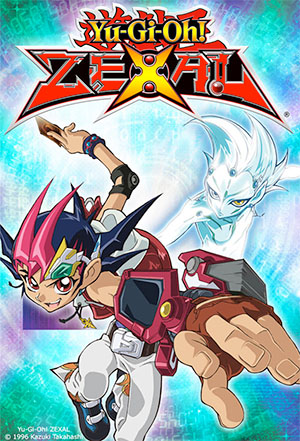
ZEXAL is the fourth Yu-Gi-Oh! series, and its plot begins when protagonist Yuma Tsukumo meets an amnesiac alien named Astral. Astral’s memories have been transformed into Duel Monsters cards, which antagonistic characters like Kite Tenjo and Vetrix are trying to gather for their own purposes. In the first half of the series, Yuma enters a tournament to recover the cards, before facing off against the man responsible for Kite and Vetrix’s villainy, Dr Faker. The show’s second half focuses on Yuma, Astral, and the redeemed Kite’s fight against another faction of aliens, the Barians, led by Yuma’s former friend Shark Kastle, as well as rogue Barians Vector and Don Thousand.
ZEXAL bears many similarities to Duel Monsters, from its dual protagonists to its arguable marginalisation of female characters.
Female characters in Yu-Gi-Oh! ZEXAL
Tori Meadows
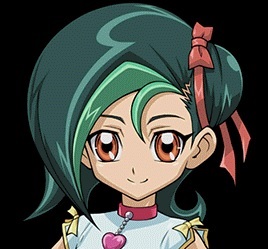
Yuma’s friend Tori is the main female character in Yu-Gi-Oh! ZEXAL. Tori is similar to Téa, in that she is not a Duelist and instead provides emotional support to Yuma and Astral. Like Téa, she does not make very many contributions to the overall plot of ZEXAL, but Tori does receive some character development, as she overcomes her nerves and confesses her romantic feelings to Yuma in the final episode.
However, Tori’s character otherwise suffers from marginalisation and harmful tropes. Tori only Duels once on-screen, and her narrative agency is further reduced by the fact that she spends the entire Duel brainwashed. She is not able to fight against the brainwashing and is problematically rendered a passive damsel in distress for Yuma to save in other episodes, as well. Furthermore, like Carly in 5D’s’ later seasons, Tori spends a lot of time bickering with another girl, Cathy Katherine, over Yuma’s affections.
Rio Kastle
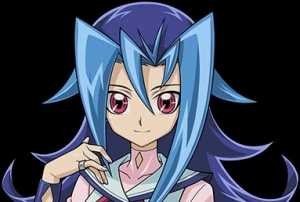
Shark’s twin sister Rio is only formally introduced in the second half of the show, after spending the first season in the hospital. She was injured by Quattro, Vetrix’s son, and one of Shark’s key motivations in the first half of the show is to seek vengeance on Quattro for what happened to Rio.
When Rio returns to Yuma’s school, her character is initially given a lot of agency. One episode focuses solely on Rio and contains a scene in which several male students develop crushes on her and try to recruit Rio into joining their clubs. Across a short montage, Rio is able to defeat all of the boys at their own games, and ZEXAL paints the boys as being in the wrong when they express jealousy of Rio’s talents and no longer want her in their clubs. The episode does not explicitly state that the boys are upset about losing to a girl specifically, but this subtext is certainly present and arguably enhances the end result of this scene, in which the boys are condemned by the narrative for their misogynistic actions. The episode continues with Rio heroically Dueling and defeating a female student who has been brainwashed by the Barians.
Despite this progressive start, Rio is problematically sidelined in other ways. Rio is injured to establish a male character’s villainy, but the focus of this storyline is given to Rio’s brother Shark, even after his revenge quest. Quattro’s redemption storyline is centred around him building trust with Shark, with Rio rarely given the opportunity to comment on her experiences or her feelings towards Quattro. During these episodes, Shark and Quattro team up to save Rio after she has been poisoned by another male villain, and once again, Rio and her thoughts on the matter are marginalised. This pattern repeats when it is revealed that Shark and Rio are Barians and Shark’s perspective is the only one foregrounded. Yu-Gi-Oh! ZEXAL marginalises Rio by making her the passive subject of events, rather than giving Rio the agency to express a perspective on what happens to her.
Yu-Gi-Oh! Arc-V
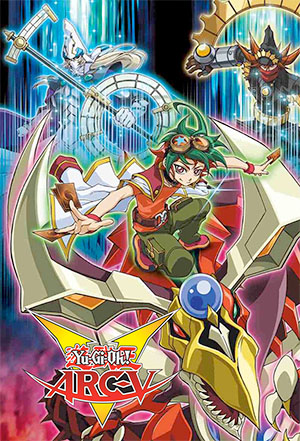
Yu-Gi-Oh! Arc-V centres around four dimensions. Protagonist Yuya Sakaki discovers that, in each of the other dimensions, there is a boy who looks exactly like him. Yuya’s friend Zuzu Boyle also has a counterpart in every dimension, and the villainous Professor from the Fusion Dimension sends his forces to capture Zuzu and her counterparts. In season one, Yuya enters a Duel Monsters tournament, only to be recruited into the Lancers, a group run by the Professor’s son Declan Akaba that aims to stop the Fusion Dimension. The Lancers travel to the Synchro Dimension in season two, where they compete in a second tournament to gain new allies. In season three, they amass more support in the Xyz Dimension, before travelling to the Fusion Dimension to fight the Professor. The Professor reveals the four dimensions were once one and that Zuzu and her doppelgangers are different incarnations of his daughter Ray, while Yuya and his counterparts are incarnations of a villain named Z-ARC. Z-ARC possesses Yuya, but is defeated by Declan’s sister Riley, who absorbs Ray’s spirit.
In contrast to ZEXAL, several female characters do play an important role in Arc-V’s storyline. However, like in 5D’s, many of Arc-V’s girls start strong, but become marginalised by later parts of the narrative.
Female characters in Yu-Gi-Oh! Arc-V
Zuzu Boyle
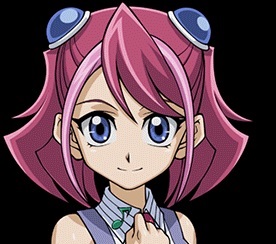
As the plot synopsis indicates, Zuzu is directly involved in Arc-V’s main plotline. This is most salient in the first season, where Zuzu’s perspective of events is foregrounded. The audience first learns about the other dimensions through Yuya’s Xyz counterpart Yuto, who gives this information to Zuzu while Yuya is preoccupied by the tournament. Unlike Rio in ZEXAL, Arc-V grants Zuzu agency by emphasising her thoughts and feelings on what is happening.
In addition to her involvement in the plot, Zuzu also receives an independent character arc. She gains a rival in Julia Krystal, and unlike the bickering between female characters in 5D’s and ZEXAL, Zuzu and Julia’s competition is about being the better Duelist. Dueling-based rivalries are a staple of Yu-Gi-Oh! and enable characters to better not only their skills, but themselves as people. Although Zuzu and Julia’s rivalry is the franchise’s first between two female characters, it is positively treated no differently from that of male characters like Yugi and Kaiba. Zuzu is driven to study new Dueling strategies, and she exhibits her skills by defeating Julia and other on-screen opponents during the tournament.
In Arc-V’s first season, Zuzu has a significant amount of character agency, as she is both involved in the main storyline and drives her own character development. Like the female characters in 5D’s, however, this positive representation is unfortunately not maintained for the length of the show. Julia is absent from seasons two and three, so her rivalry with Zuzu does not continue, and Zuzu is not given a second character arc by the narrative. Zuzu continues to be involved in the storyline during season two, as she participates in the Duel Monsters tournament, but her agency is dramatically reduced in season three. She is kidnapped by the Professor’s forces and spends multiple episodes as a mind-controlled damsel in distress. Despite Zuzu’s passion for Dueling earlier in the show, she does not Duel in season three, and she likewise does not play an active role in this season’s main conflicts against the Professor and Z-ARC.
Celina
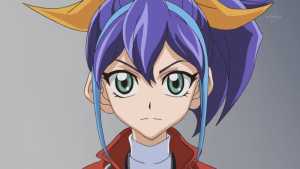
Zuzu’s Fusion Dimension counterpart Celina similarly begins the series as a positive representation of a female character. She initially works for the Professor, and undergoes a character arc in which she realises that what she is doing is wrong. Celina joins the Lancers and actively supports their efforts in season two by participating in the Synchro Dimension’s Duel Monsters tournament. Like Zuzu, however, Celina spends a majority of the third season brainwashed, which significantly reduces her narrative agency.
Lulu Obsidian & Rin
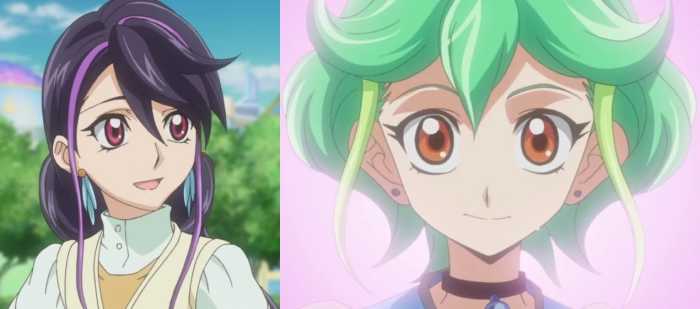
Zuzu and Celina’s Xyz and Synchro Dimension counterparts, Lulu and Rin, were both captured by the Professor’s forces before the beginning of Arc-V. Neither girl appears in the first two seasons outside of short flashbacks, and their kidnappings serve to motivate not only the story, but the involvement of male characters in that story. Lulu’s brother Shay Obsidian and love interest Yuto both strive to rescue her, while Rin’s capture motivates her love interest Yugo. When Lulu and Rin do appear in season three, they spend nearly all of their screen time mind-controlled, like Zuzu and Celina. Consequently, it can be suggested that both Rin and Lulu have limited narrative agency, as they spend nearly the entire show as damsels-in-distress for male characters to save.
Ray Akaba
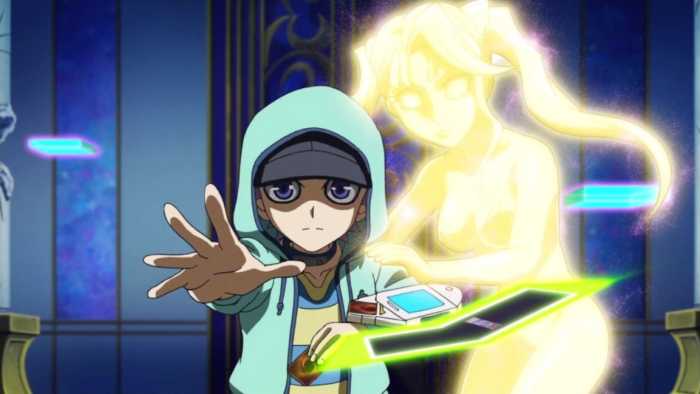
Ray plays an important role in Arc-V, as it was her actions that split the world into four dimensions in the first place. She is also a very heroic character, as she defeats Z-ARC at the end of season three. In some regards, Ray is a progressive representation of a female character because her heroism is significant to the narrative. However, Ray is marginalised in other ways. Aside from her defeat of Z-ARC and a single flashback, Ray does not appear in the anime. This lack of screen time results in few opportunities for the audience to learn who Ray is as a character outside of her moments of heroism. Consequently, despite her role in the narrative, the strength of Ray’s character is weakened by how little time the audience spends with her.
Riley Akaba
As stated earlier, Riley is also instrumental in the defeat of Z-ARC. Before this, she serves as one of the heroic Lancers, and Riley also receives a character arc in navigating the trauma she experienced before the series began. For a majority of Arc-V, Riley is a positive representation of a female character, but this is interestingly only revealed towards the end of the show. Up until the end of Arc-V, Riley’s gender is not explicitly stated, with many fans assuming that the character was male because of her similarities with past younger brother characters like Mokuba Kaiba in Duel Monsters and Hart Tenjo in ZEXAL. Riley is only confirmed to be a girl during her final moment of heroism, when she and Ray team up to stop Z-ARC.
Arc-V’s choice to treat the reveal of Riley’s gender as a plot twist is, in some regards, subversive, as it challenges audiences’ preconceived notions that only boys can be heroes. The subversion of this idea is particularly impactful in the Yu-Gi-Oh! franchise because it implicitly critiques the franchise’s lack of female heroes in the four series preceding Arc-V. On the other hand, the twist could also be interpreted as indirectly reinforcing the tropes it is trying to subvert by depicting the existence of a female hero as a shock, rather than as something normal.
Yu-Gi-Oh! VRAINS
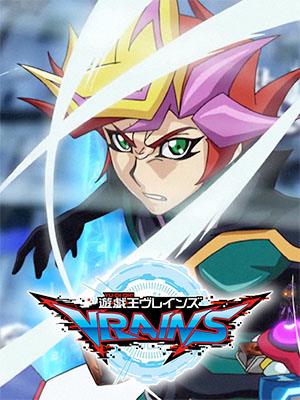
Yu-Gi-Oh! VRAINS is primarily set in LINK VRAINS, a virtual world for Duelists. When the show begins, protagonist Yusaku Fujiki is searching LINK VRAINS for the Knight of Hanoi, a group of villains responsible for his childhood trauma. The Knights previously held Yusaku and five other children hostage to create six sentient AI known as Ignis. In the first season, Playmaker teams up with Ai, one of the Ignis, to fight the Knights of Hanoi and their leader Varis. In the second season, Theodore Hamilton – another victim of the Knights – and his Ignis Flame join Yusaku and Ai. The group battle against Bohman, a sentient AI created by a villainous Ignis named Lightning. After losing all of the other Ignis, Ai becomes a villain in VRAINS’ final season, and Yusaku must defeat him.
The final series produced by Nihon Ad Systems and Studio Gallop, VRAINS makes a few changes to the traditional Yu-Gi-Oh! formula, but its representations of female characters still bear many similarities to that of the five preceding series.
Female characters in Yu-Gi-Oh! VRAINS
Skye Zaizen
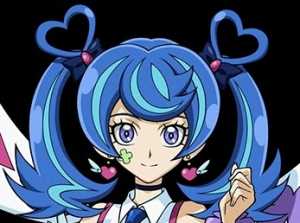
VRAINS’ main female character is Skye, but unlike past female leads, she is not a close friend of Yusaku’s. She also differs from previous female heroes in that she is involved in the main plotline of every season and Duels against several important villains across the course of the show. Skye’s role as a hero also compliments her two character arcs: gaining independence from her step-brother Akira and defending her friend Miyu Sugisaki. By engaging with important storylines and having the agency to drive her own arcs, Skye’s character arguably improves on some of the franchise’s past pitfalls when it comes to representing female characters.
However, Skye’s character is not completely free of problematic tropes. Throughout the first two seasons, her losses in Duels are sensationalised significantly more than that of the other characters. Most notably, when Skye loses a Duel to Specter, a Knight of Hanoi, she crashes face-first onto the ground in a very dramatic manner. Despite the hardships Skye experiences not only after this loss, but in some of her other Duels as well, the show does not give focus to her feelings towards or reflections on these events. As a result, the scenes arguably feel like they are included for “shock value” rather than to develop Skye’s character.
Emma Bessho
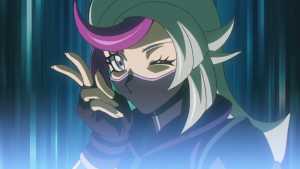
Emma is a supporting hero who, like Skye, is involved in the main plotline of each season. Similar to the female lead, however, Emma’s agency in the main storylines is hampered by her reoccurring losses. Emma does Duel against significant opponents, but she is unable to advance the story by winning. More positively, she is able to use her technological skills to help Yusaku, such as obtaining blueprints for the Knights of Hanoi’s plan. Unfortunately, like the information Ishizu gives to the Pharaoh and Kaiba in Duel Monsters, the emphasis is still placed on what the male characters do with the help rather than on the female character who found the information in the first place.
More positively, Emma also receives her own character arcs in becoming more of a team player and in connecting with her brother the Shepherd. While she does not cement either of these arcs with Dueling victories, Emma’s agency in Dueling allows her to visibly demonstrate her character development, as she Duels to help the team and alongside her brother. As a result, it can progressively be suggested that Emma exhibits narrative agency during her arcs.
Male characters in Yu-Gi-Oh!
Finally, this article will touch on another element of gender representation. In addition to how female characters are represented, it is important to note whether a story’s male characters are depicted in ways that promote or discourage respect towards women and girls to the audience. In the real world, toxic forms of masculinity are very harmful to girls and women because they normalise poor treatment of the female population, and can even hurt boys and men by endorsing attitudes that harm one’s mental health. Behaviours associated with toxic masculinity include emotional repression, violence, and unhealthy competition. For a story to have positive gender representation, it can be suggested that it must not endorse harmful attitudes like toxic masculinity. There are too many male Yu-Gi-Oh! characters for this article to discuss all of them, so I will analyse a key few whose storylines comment on toxic masculinity.
Yugi Muto
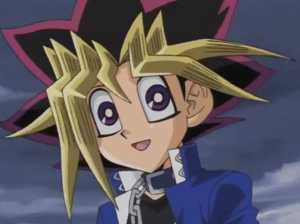
Yugi is one of the dual protagonists in Duel Monsters. He does not receive as much screen time as the Pharaoh, but still has a large impact on the plot in each main storyline, from helping the Pharaoh to defeat Pegasus, to saving Joey from Marik, and ultimately to completing the Pharaoh’s return the afterlife. While the Pharaoh is the more foregrounded of the two, the narrative arguably paints Yugi as the most heroic character in the show. Not only does he defeat the Pharaoh in the final Duel of the anime, but throughout the show, Yugi is presented as more moral than the Pharaoh.
Yugi’s heroism is refreshingly accompanied with a non-toxic portrayal of masculinity. As stated earlier, friendship is a key virtue in Yu-Gi-Oh!, and Yugi is unique even amongst other characters in the series in his willingness to express love towards his friends. Toxic masculinity dictates that boys not be emotional or show affection, especially with each other, but Yugi defies this problematic attitude. He and the Pharaoh comfortably call each other “aibo” (the Japanese word for “partner”, which has a much more affectionate connotation than its English counterpart) and, on one occasion, Yugi tells Joey that he loves him. Not only does Yu-Gi-Oh! progressively not critique Yugi for these behaviours, but it implicitly indorses his non-toxic masculinity by presenting Yugi as the show’s greatest hero.
Zane Truesdale
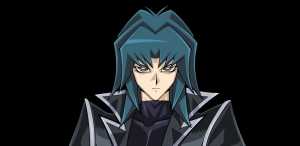
In Yu-Gi-Oh! GX’s first season, Jaden’s rival Zane is a heroic character who helps to defend the school from the Shadow Riders. Zane’s aloofness towards his brother Syrus is depicted as a negative quality, but he is a polite and encouraging rival towards Jaden. Throughout the first season, Zane does not exhibit any toxic masculinity, but this changes in the second season and is presented as a change for the worse by the narrative.
Zane graduates from Duel Academy at the top of his class, but when he tries to become a professional Duelist, he begins a losing streak he cannot overcome. Zane is greatly shaken by his failures and turns to violent underground Dueling to deal with his insecurity. In contrast to the series’ conventional supernatural violence, underground Duels do not rely on magic and instead electrocute participants using technology. Zane’s turn to violent Dueling is fuelled by an unhealthy desire to win Duels at any cost and is accompanied by him developing a cruel attitude. Zane also represses his emotions, as he refuses to accept help from people who care about him (Syrus, his friend Atticus, and even the principal of Duel Academy). GX progressively presents Zane’s toxic masculinity as something negative, as he ends up significantly injuring himself and almost loses his life. In season four, Zane is able to reconcile with his brother only after he loses his obsession with being the best Duelist and instead provides emotional support to Syrus.
At later points in the series, the storylines of characters like Jack in 5D’s and George Gore in VRAINS similarly link over-competitiveness with emotional repression and violence, and portray this toxic masculinity as a flaw that needs to be overcome.
Jesse Anderson
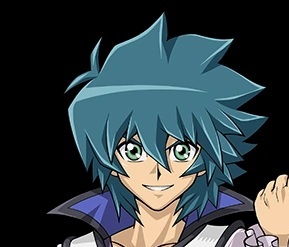
Introduced in GX’s third season, Jesse’s character subverts not only toxic masculinity, but other traditional expectations of how boys and men should conduct themselves. Beyond his high-pitched voice and frilly, lavender-coloured shirt, Jesse is arguably queercoded (given attributes to imply that he is LGBTQ+), as he is associated with rainbows, is the only character in the franchise to summon Duel Monsters with the expression “come out”, and has an affectionate relationship with Jaden that is assumed by Yubel to be romantic. Toxic masculinity derides unconventional expressions of masculinity such as this for challenging and disrupting societal norms regarding self-expression, so GX’s portrayal of Jesse as a hero is arguably subversive. Throughout the show, Jesse has the agency to rescue his own Duel Spirit when it is captured, and he also defends Duel Academy from Yubel’s forces. Later in season three, Jesse becomes a damsel in distress for Jaden to save, but Yubel is only able to capture Jesse because he makes a heroic sacrifice to protect the rest of the school. After being rescued, Jesse returns to his heroism in season four, as he Duels against Nightshroud with Jaden.
Z-ARC
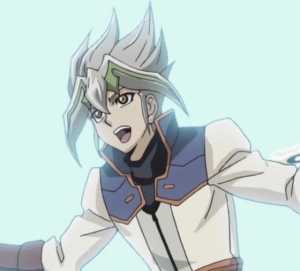
The main antagonist in Arc-V, Z-ARC’s villainy is defined by his violent style of Dueling. Z-ARC’s backstory reveals that he became a violent Duelist in part because his in-universe audience cheered for him more when he Dueled in this way. Z-ARC conformed to this expectation out of desire to be the best and most popular Duelist. Through this storyline, Arc-V is inadvertently presents Z-ARC as having toxic masculinity, as his unhealthy competitiveness drove him to violence. In the real world, boys and men can adopt toxically masculine behaviours because doing so is encouraged and even rewarded by society, and this is reflected in Z-ARC’s character. Within the show, however, Z-ARC is presented as being in the wrong for conforming to what other people expected of him.
Yuya, one of Z-ARC’s reincarnations and the show’s protagonist, is horrified by Z-ARC’s actions. Like Z-ARC, Yuya is dedicated to making people smile with his Dueling, but he seeks to achieve this with a peaceful style of Dueling. At the end of the series, Yuya defeats Z-ARC not through any kind of fight, but by pacifying him with Duels that are entertaining while remaining peaceful.
Although Yu-Gi-Oh! is a largely enjoyable and well-written series, its representations of female characters have relied on some less than progressive tropes. Despite this, Yu-Gi-Oh! arguably does offer a positive portrayal of non-toxic masculinity. Consequently, Yu-Gi-Oh!’s gender representation promotes conflicting messages to audience, and it is difficult to call the show universally sexist or entirely subversive. The most important takeaway is that it is important to be mindful of problematic aspects of media we otherwise love.
What do you think? Leave a comment.




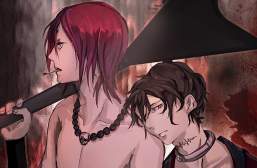




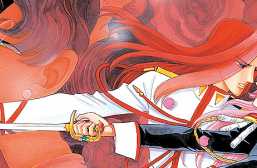

One of the most all in compassing write ups of Yu Gi Oh. Honestly I fell off the anime around when GX started but this was a good read. Great job. Question though, was this based on the Dub or the Sub translation? I’ve heard the subs are a bit better for characterization.
Thank you for your kind words. Although I used the dub names, I primarily wrote about the original Japanese versions of the shows.
My wife has been wanting to get into this game but she cant stand the language used by people and the sexism. It’s very toxic.
I would say this is a big issue that needs to be addressed. On the side of attracting women players, it would seem to me that Konami should try to address that, along with the community trying to outreach and get more women playing.
I don’t think Yugioh was made for girls. KONAMI and Kazuki Takahashi obviously made the series and the game to be watched and played by somehow marginalized men who don’t/can’t fraternize in traditional ways.
Yeah Takahashi def has his kinks that he put into the stuff he created for this series. But also at least for me and the ppl in my life that have played or watched Yu-Gi-Oh, its more at the level of annoying. Like fuck can we please have a female protag/main rival please. Like Id love a Mia like protag, as a kid I thought Mia was sooo cool. And for the cards yuuuuup def can tell the ones that Takahashi had a certain taste for lol but in more modern sets there at least it feels to me, plenty of female cards that arent just horny. Like Dragonmaids, love them, they cute as fuck! look at Parlor stealing food in Hospitality, that some cute shit right there. Darklords are another one, only has a few female cards but I love their designs especially Condemned Darklord, she looks so awesome.
Basically what Im trying to say, there are def plenty of women who watch the anime and enjoy it. So the general bad anime problems aren’t whats turning us away. Its that the IRL community doesnt feel welcoming/inviting. Especially if you dont have any friends in the community to help you join it.
Im trying to get into it now for the first time since like 2004. Want to build a deck around Fobidden / Darklords and see if I can win even one match at locals. But I feel really nervous and unsure about actually entering a locals, it doesnt help that Im a transwoman and so ill have the added fun of will anyone here be transphobic too me?
Sometimes I feel attitudes towards women playing videogames or TCGs have barely changed since the 90s.
I hope woman can get into the game and enjoy it as much as I do.
This is the case with so many anime shows unfortunately, ‘oversexualizing’ isn’t exactly a new problem in anime, on the contrary. Some genres purposefully use that to gain a steady viewership. There is literally a genre that focuses on a guy who is swarmed by a group of girls and he’s the tragic center of the show cause he can’t decide which one to kiss. But even ‘regular’ anime do this, especially older shows. It seems like they almost refuse to reinvent themselves and adapt to todays ‘standards,’ as is the case with One Piece or Dragon Ball for example. Those are still going on and they too have a major problem when it comes to portraying female characters.
More recent anime shows, that don’t heavily focus on nudity/fanservice, are much more progressive in this sense, that they don’t reduce their female main protagonist to a platitude by working in a subtle panty/booby shot every once in a while. Most shows still do this to some extent though, so there’s still a long way to go.
‘oversexualizing’ isn’t exactly a new problem in anime
Why is it even a problem? The market is split 50/50 between demographics, especially the manga market has a lot of female talent creating fap artwork for other women. It’s a pretty balanced market with every demographic getting what they want.
Men get the sexy scantily clad women, women get the androgynous shirtless and a little bit gay men. Everyone’s happy, where is the problem?
Oh, yeah, “harem” anime and manga (and NOVELS, ugh >:/).
I believe there is also reverse harem anime and manga so im not sure what point you are trying to make??
Male characters there are not nearly as sexualized as female characters in harem VNs or shows.
Man i used to watch the heck out of this show as a kid.
Have you seen Season 0, the anime that came before it that was about the early stuff and had Dark Yugi killing people (and very few card games)?
I highly recommend it if you haven’t because it’s very good.
Oh, Mai. I was always so hopeful about how they might develop her character, but after the bit of development early on, they had a whole thing about her regressing because she wasn’t as good as Joey or Yugi, and then it just became a ‘Joey has to save Mai from herself’ story.
And Joey always seems like he had to have a female character in trouble for him to save. First it’s his sister and her operation, then it’s Mai.
They even have some of the female characters that aren’t duelists duel at a few different times, and it usually ends up being ‘haha, they don’t know what they’re doing… oop, they won through luck (or because one of the guys helps them out)!’
I feel like the saving aspect of the first series is that different from other shounen the female characters mostly avert any sort of rivalry, and even form sister-ish relationships. But it’s a very small and forgettable part of the series, and it’s never played with. By the way, why nobody is mentioning Rebecca? she is a genius in-universe, she usually did realistic plays (as far as it was possible for the first series, anyway) and changed decks with some frequency, which is also something meta players do.
I thought about Rebecca, but even her characterization wasn’t great. She started out with the usual ‘I hate you because of a misunderstanding’ type thing, but then she turned into stereotypical clingy girl in love character with no regard for a return of the affection from Yugi (and a way to make Tea jealous).
Well, that’s true. Unfortunately YGO female characters are wasted opportunities.
Used to love it that show as a kid, but yeah always hoped that the girls would get better roles. I flippled through the rules recently and maaaan the game has gotten really complicated.
One thing that annoys me is how much of Mai arc revolves around “humbling” her. This sort of narrative never happens to male characters in the same way, they’re always allowed to keep their pride and still win at the end of the day.
Female humbling arcs should be burned to the ground.
ARC-V has arguably the best characterization and presence of female characters of the franchise. Even then it fails short at other series out there.
Zexal treatment of Kotori was extremely gross, yikes.
Are any of the new ones even good. I stopped after 5d.
I didn’t like Zexal but I think Arc V is decent. For female protagonists though I thought Alexis and Akiza had great potential. In later seasons I felt they got neglected in favor of the other characters unfortunately.
In 5Ds it felt like they first forgot about the other characters who were not Yusei, Crow and Jack, and then realized their mistake and tried to develop Akiza motivations again…and then stopped. It was really frustating.
Yet another reason why Pokémon is better.
Pokemon is not without its problems. I personally found the Yu-GI-Oh anime far more interesting than the generic 8-badge never growing up adventures of Ash the worst trainer in the world.
And besides, Digimon > Pokemon any day if you want to talk about story.
Though Pokemon is guilty of that as well, remember Beauty and the Beach?
I liked Ishizu. She was a skilled duelist and a pretty interesting character. She more interesting in the manga than the anime and so was Anzu.
It amazes me sometimes that some shows seem to really try to alienate people outside their key demographic. I was roommates with a 50 year-old woman who wrote porny Yu-gi-oh! slash. Fandom finds a way.
To be perfectly honest.. do we actually expect better of a anime or manga created by a man for a publication for teenage boys (Shonen) from a culture where women are treated as second class?
In every series, women got the short end of the stick. They did not get the same number of duels as the male cast and any duel they participated in were not essential to any of the plots occurring through the classics to vrains.
In addition, every one of these series had at least one scene where either a female character had to be saved by the male protagonist from a serious threat or ended up getting brainwashed. Not only do I think it’s stereotypical, it also made me wonder if the writers had a fetish for such. In more recent years, the card game releases more monster cards with women on them then they did 20 years ago. It’s like a symbol that the yugioh franchise is basically objectifying women and alienating any female fans just to bank on male consumers. That kind of mentality is certainly ludicrous.
I think Konami needs to market this game towards both boys and girls and I feel like an easy way to do that would be, to have a female protagonist for the anime. Its something fans of the show have been wanting for awhile anyway but Konami doesnt wanna do it for some reason. Although I haven’t watched this anime for a few years so who knows if they changed.
I know, YGO anime is a shounen and stuff, but seriously people. Give me a girl who is the rival if a female main character is too much for a shounen. And don’t let her become love interest.
Great article. Let’s face it, the first experience most had with the game was thanks to the anime, and how the anime as portrayed girls over the years? Anzu was a cheerleader girl who barely dueled. Azuka had so much potential but was victim of chickification. Aki, when she was good at dueling she was evil, and when she was good she wasn’t dueling as much; and even though she got a licence to have card games on motorcycles she didn’t turbo duel. Kotori another cheerleader. Yuzu, SO MUCH POTENTIAL, REDUCED TO DAMSEL IN DISTRESS ALONGSIDE THE OTHER BRACELET GIRLS, EPECIALLY SERENA! AND WHEN RIN AND RURI DUELED, THEY EVIL!
I remember one of the coolest duels in the Yu-Gi-Oh! Anime…… were between two guys with a woman as the “prize”.
Was that the one with Johnny Steps?
Valon. but that too…
That is the worst and dumbest duel in the series in my opinion. The fact that the Mai Joey duel following this one basically confirms that Mai would win makes me feel a little bit less annoyed, but very little.
Shounen and Japan have just as much female representation problems as in the US.
Best way to solve this… more female anime and manga artist.
You can’t judge two industries on the occasional show or comic that manages to makes it big outside of it’s native country. There is more to anime and manga than the Saturday/Sunday morning bubble.
You do know mostly all mangkas are single artist. If you read Bakuman you understand that the readers choose which series would be popular. And it could be any author, male or female.
I would say that ARC-V was doing a “ok” job. Yuzu could easily be the protagonist of the series, and yet the focus is on Yuya, even if the characters have similar traits, abilities and motivations.
The demographic for Shounen manga is usually teenager boys, as such the women are writing to appease what they few teenage boys will like. One Piece, Naruto, Fairy Tail etc etc all have this problem. The only real exception of a huge Shounen series with well written female characters I can think of is FMA (Which was written by a women)
However when you branch out of the Shounen side of anime that really isnt the case that much. You just need to look no further then last year to see some well written and interesting females.
Shounen manga is just always have that problem I guess.
Shounen has really no meaning anymore – see Haikyuu or that Basketball anime or if not sports, look at Gintama. The fanbase for those “shounen” anime is 90-95% female.
Much better way to divide stuff:
If it’s not a battle shounen than => Lots of guys in it = it’s most likely for girls. Lots of girls in it = it’s most likely for guys.
I wouldn’t call this a specific Yu-Gi-Oh! problem, but a Shounen-genre problem, since those manga and anime adaptations all very closely follow the same group of tropes.
Like how in Dragon Ball there isn’t a true female fighter, nor a female Super Saiyanjin (Toriyama was once asked why Pan had become a SS and he said he wouldn’t know how to draw her in the state); how in Naruto the female characters are either useless or a burden and none of them get the chance of being a great fighter; in Saint Seiya the only relevant female character is the reincarnation of Athena, whom despite being the Goddess of Military Strategy never battles and always acts as a Barrier Maiden, etc, etc.
The only big exception was FMA, where the women were often not the most badass characters (hello there Housewife and Northern Wall of Briggs), and even when they weren’t fighters they exceled at their field.
It’s sad because Toriyama will create good female characters and then just… not use them. Like why couldn’t Videl learn to fight on the level of Krillin or Yamcha? Why does 18 not do more when she’s far stronger than any human?
And Toriyama CAN create good female characters in main roles. Hello, Chrono Trigger.
Those cases fall more on another usual Shounen trap. The enemies get so powerful only the main characters are able to match them, which in DG terms means only Super Saiyans or fused Super Saiyans. All the male human fighters became a non factor during the Android saga.
Nice article! Always good to read about it as shounen animes has some weird issues about sexism even today.
What a thoughtful and thorough breakdown. Great read!
As you yourself said, “it is impossible to objectively define a “positive representation” of, for example, a female character.”
Every female Yu-Gi-Oh! character is allowed to be however she is.
In the end, it is subjective. If you don’t like Yu-Gi-Oh!, don’t watch it, but don’t try to bash it with “arguments” that are just subjective opinions.
I have watched Yu-Gi-Oh! many time. Only find male characters leads with passive girls, not women. The female villins aren’t even close of being evil compared to their male counterparts. The story is always base on boys growing up, not a girl growing up becoming a woman. The article out these points in well written way.
What about Romin from Sevens. That has a surprisingly solid portrayal of females.